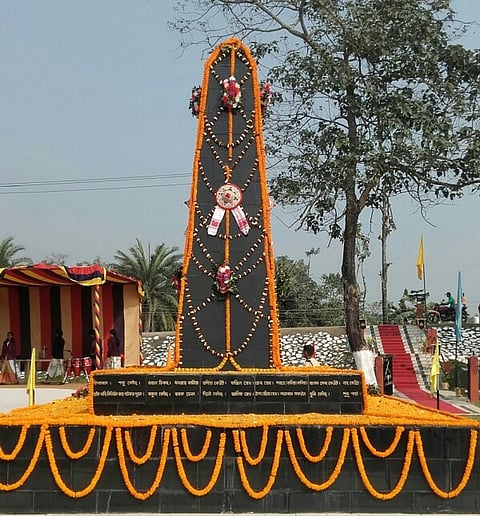
- Home
- Live Blog
- Breaking News
- Top Headlines
- Cities
- NE News
- Sentinel Media
- Sports
- Education
- Jobs

Our Correspondent
MANGALDAI: The supreme sacrifice of 140 Krishak Swahids who were brutally gunned down by the British government at Pothorughat in Darrang district on January 28 of 1894, after a long wait of 125 years finally got its mention for the first time on the floor of the Parliament. Making an exception to all his predecessor Parliamentarians from Mangaldai HPC or the Rajya Sabha members from Assam who were not at all aware of this glorious yet tragic chapter of the history of India’s freedom struggle, the young BJP Parliamentarian from Mangaldai HPC Dilip Saikia on the very first session of the Lok Sabha on July 4 raised the historic Krishak Vidroh at Pothorughat which took place 25 years ahead of Jalliwanbala Bagh Massacre and demanded to grant the national honour and recognition to this Krishak Vidroh and to those 140 Krishak Swahids.
Various organizations including Mangaldai Media Circle, Pothoru Samanway Gosthi, Mangaldai Sambad Sahitya Chora has highly appreciated the spirit and effort of Parliamentarian Dilip Saikia in granting the national honour and recognition to Krishak Swahids and to the Krishak Vidroh.
Mention may be made here that the village peasants of Darrang district on that fateful day of January 28 of 1894 without any specific leadership that too in a non violent way lodged protest against enhanced land revenue imposed by the colonial British rulers. While the national media since the Independence have been showing indifferent attitude towards this unique and spontaneous peasant’s rebellion, but The Amrit Bazar Patrika dated February 14 of 1894 made the most valid point in the editorial while differentiating the uprisings in Assam from peasants-artisans movements in other parts of India with reference to the historic peasants uprising at the sleepy village Pothorughat. “In the Deccan the fury of ryots was directed against money- lenders, in Bengal against indigo- planters, in Pabna against Zamindars, but in Assam, at this moment, it is open rebellion against the government” –it was mentioned in the editorial.
This tragic yet glorious chapter of the freedom struggle of India, still neglected by the historians of the country, perhaps, is the first instance of passive and non- violent resistance to acts of oppression in entire India, which was the purest and most perfect form of philosophy of Satyagraha taken up much later by Mahatma Gandhi only in 1919. This can be evident from the report submitted by then Deputy Commissioner of Darrang JD Anderson who ordered for firing upon the innocent peasants to the Commissioner of Assam Valley Districts on January 30 of 1984. “I informed them of the orders passed by the Government of India as to the rates of revenue, and then directed them to disperse, going among them freely and talking to them of the inevitable consequences of a refusal to disperse. They remained firm, however, and, without in any way assaulting or abusing me, simply refused to budge” this was the point made by the Deputy Commissioner on the peasants assembled on that fateful day at Pothorughat. All the pan- Indian incidents of resistance against the British throughout the 19th century had been armed uprisings.
But the courageous peasants of Darrang district assembled at Pothorughat on that day had defied the government using the weapon that Gandhiji would many decades later project as an instrument to bring the freedom to the country.
The Pothorughat episode is also a glaring example of traditional religious harmony, unity and cooperation of Axomiya society as peasants belonging to both the Hindus and Muslims fought and died side by side for a common cause. The rare sacrifice of these 140 peasant Martyrs later became the source of inspiration to strengthen the fraternal bonds leaving a shining example to the entire nation. The State government in 2017 for the first time celebrated the Krishak Swahid Divas at Pothorughat granting it the official recognition. The Red Horns Division of Indian army has also been celebrating the Day in full military style and honour on January 29 in which the GOC of Red Horns Division is the regular chief guest since 2000. Mention may be made here that at the initiative of then Assam Governor Lt. Gen. S K Sinha, the Red Horns Division constructed a memorial structure at Pothorughat which is the only memorial in the country to be constructed by the Army in memory of peasants or civilians.